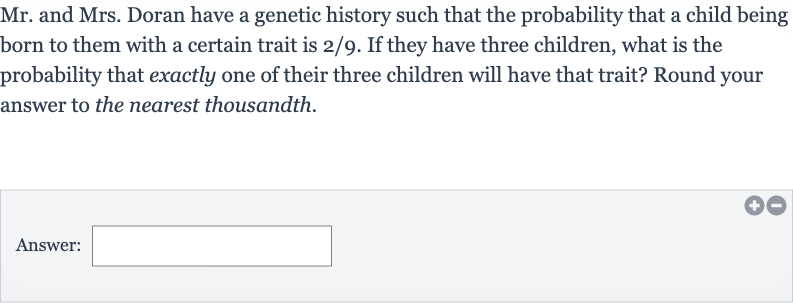AI tutor
Welcome to Bytelearn!
Let’s check out your problem:

Mr. and Mrs. Doran have a genetic history such that the probability that a child being born to them with a certain trait is /. If they have three children, what is the probability that exactly one of their three children will have that trait? Round your answer to the nearest thousandth.Answer:
Full solution
Q. Mr. and Mrs. Doran have a genetic history such that the probability that a child being born to them with a certain trait is /. If they have three children, what is the probability that exactly one of their three children will have that trait? Round your answer to the nearest thousandth.Answer:
- Identify Probability and Events: Identify the probability of a single event and the total number of events. The probability of a child having the trait is , and the probability of a child not having the trait is . Since they have children, we will consider three separate events.
- Calculate Probability of One Child: Calculate the probability of exactly one child having the trait. The scenario where exactly one child has the trait can occur in three different ways: the first child has the trait and the other two do not, the second child has the trait and the others do not, or the third child has the trait and the others do not. We will calculate the probability for one scenario and then multiply by since each scenario is equally likely.
- Calculate Probability for Scenario: Calculate the probability for one scenario.For the first child to have the trait and the other two not to have it, we multiply the probabilities of each independent event: .
- Perform Calculation for Scenario: Perform the calculation for one scenario..
- Multiply Probability by Scenarios: Multiply the probability of one scenario by the number of scenarios.Since there are three scenarios where exactly one child has the trait, we multiply the result from Step by ..
- Simplify Fraction and Round: Simplify the fraction, if possible, and round to the nearest thousandth. can be simplified by dividing both the numerator and the denominator by .So, the simplified probability is . To round to the nearest thousandth, we divide by ..
More problems from Find probabilities using the binomial distribution
QuestionGet tutor help
QuestionGet tutor help
QuestionGet tutor help
QuestionGet tutor help
QuestionGet tutor help
QuestionGet tutor help
QuestionGet tutor help
QuestionGet tutor help
QuestionGet tutor help
QuestionGet tutor help
